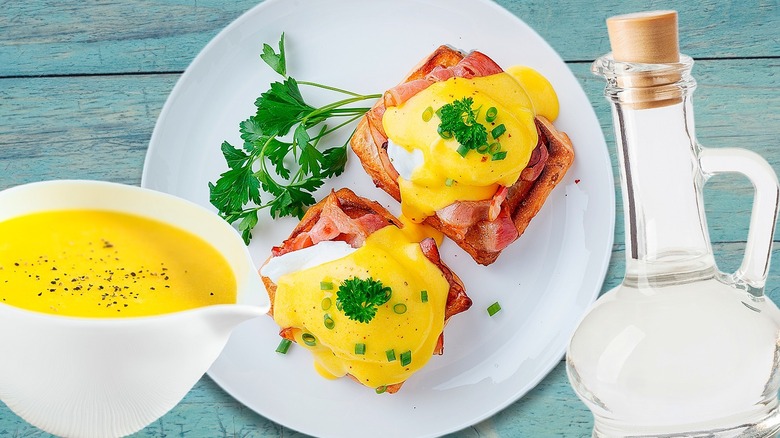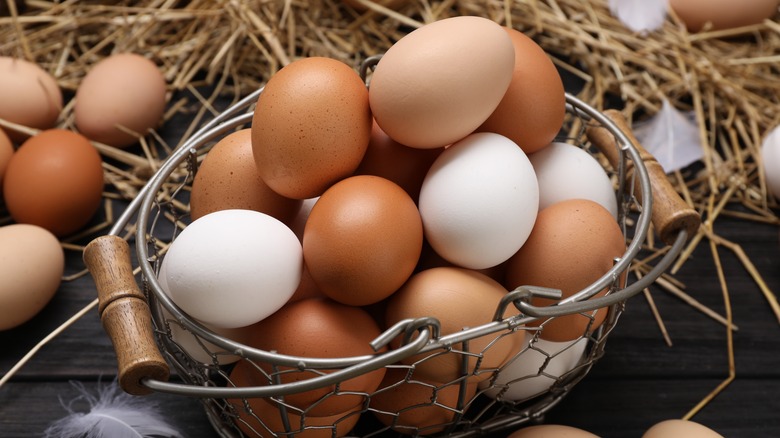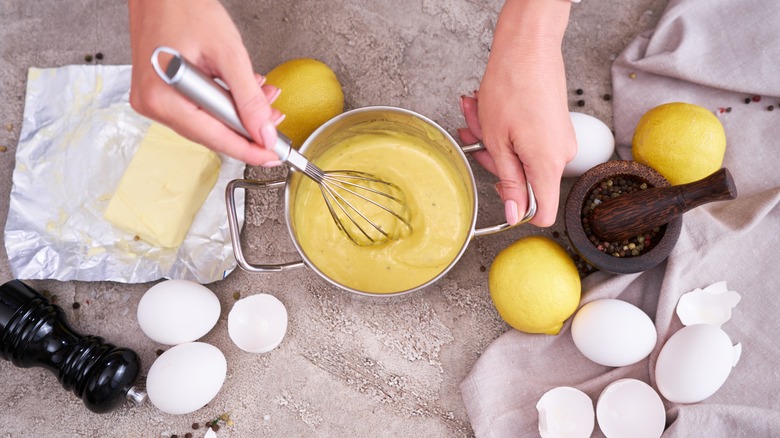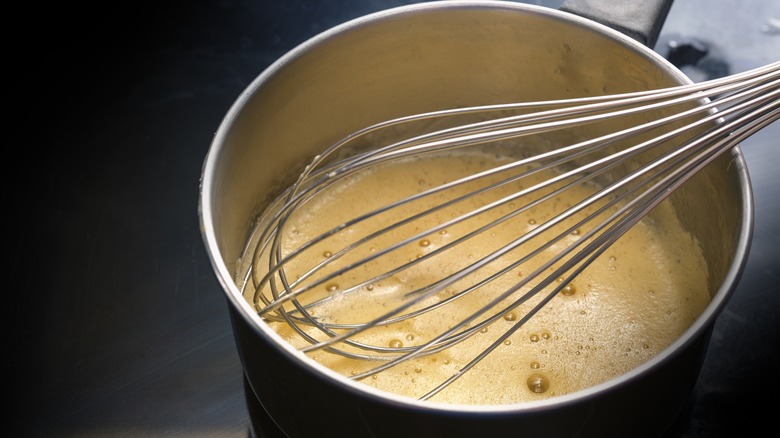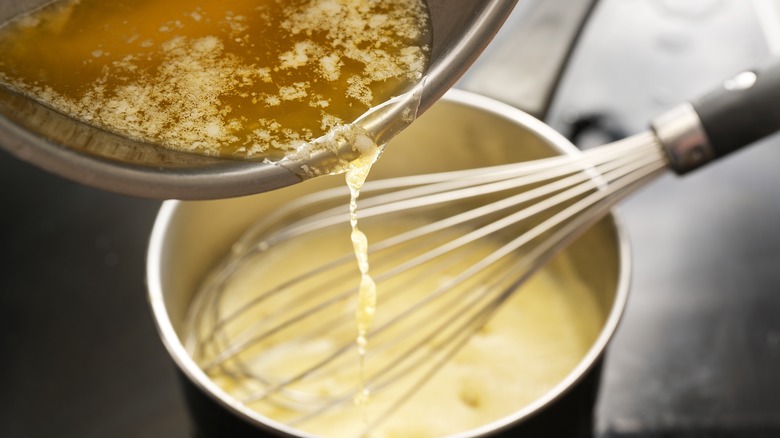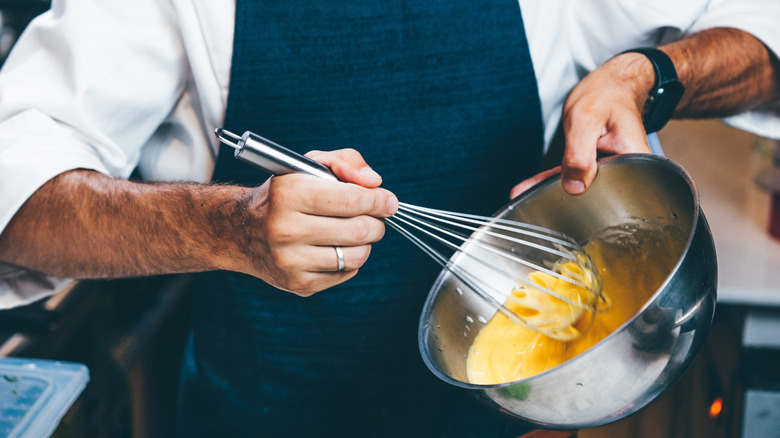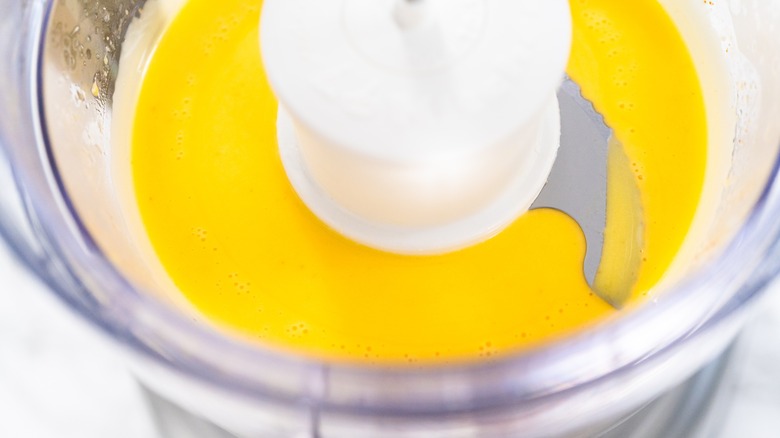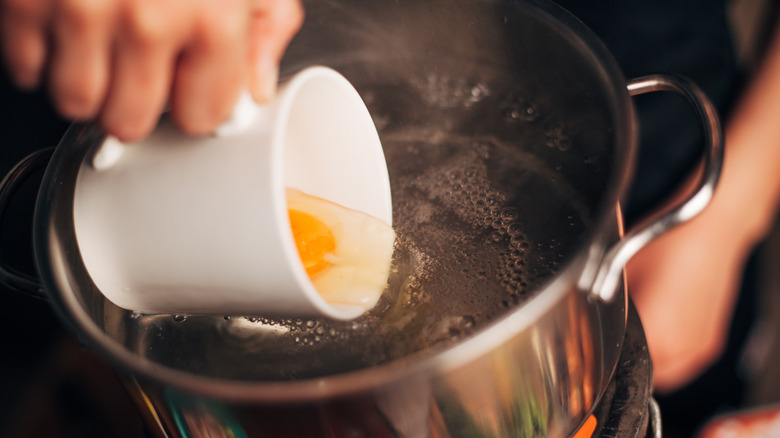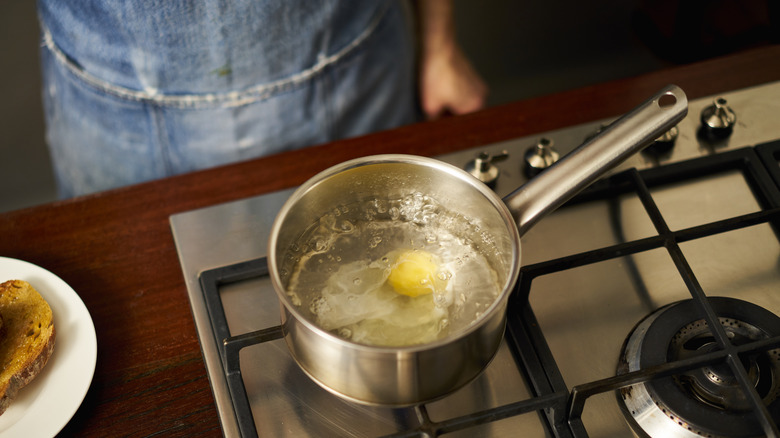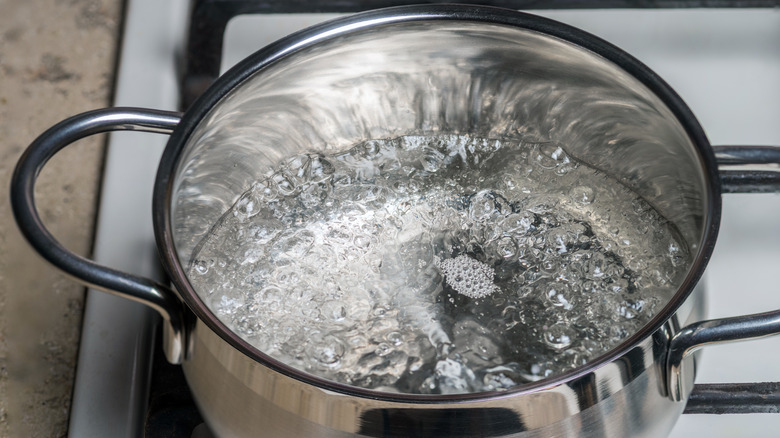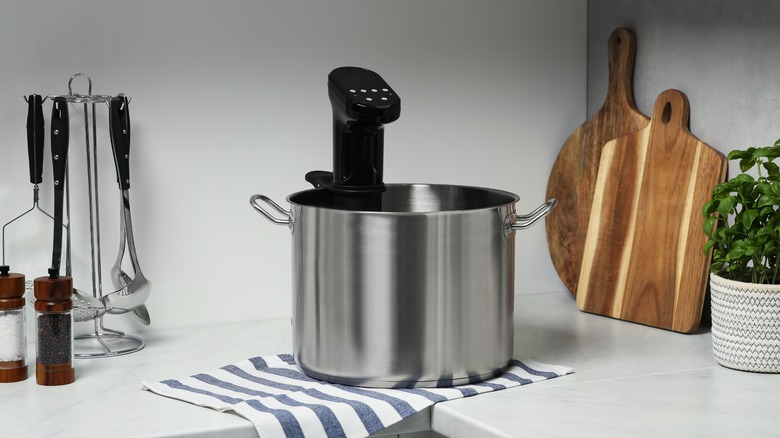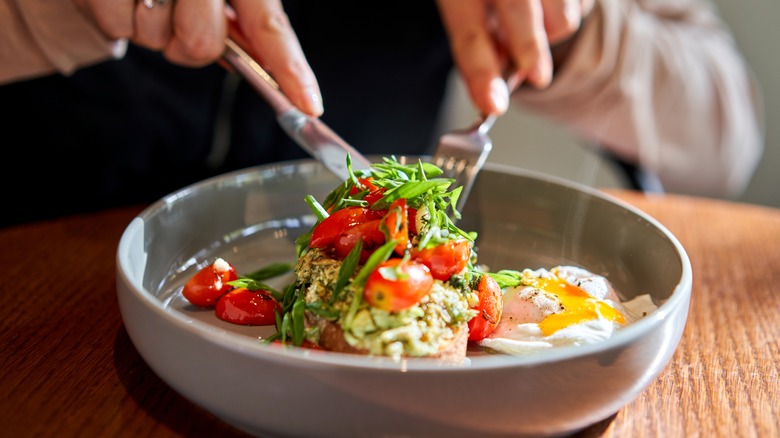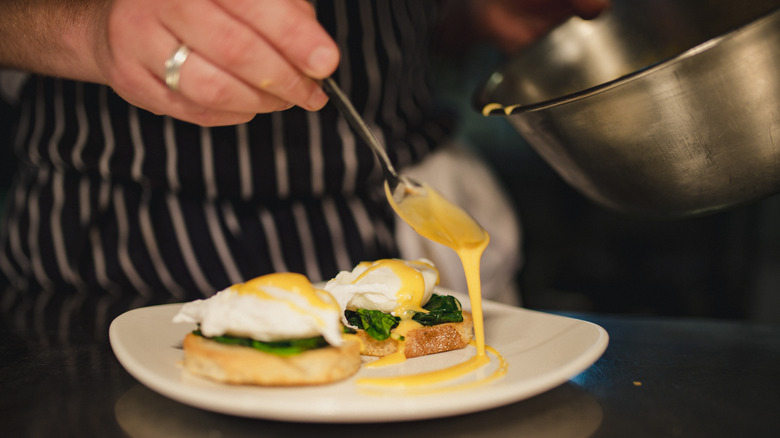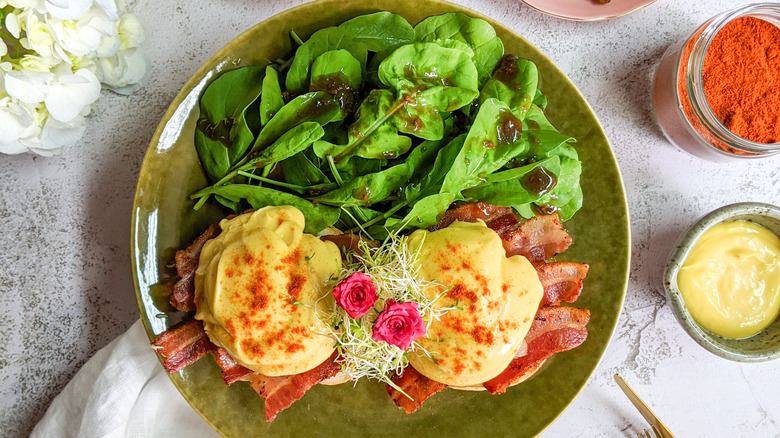13 Tips You Need To Cook Eggs Benedict Like A Pro
Eggs Benedict is one of those dishes that can be absolutely amazing if done right, but pretty abysmal if not executed properly. It's a tricky dish to master thanks to all the steps involved. A good eggs Benedict should have perfectly poached eggs with springy whites and silky yolks, lusciously creamy hollandaise sauce, and a bread base that gives just the right amount of crunch, while still being tender. For many home cooks, it's all too much pressure. But it doesn't have to be that way.
If you've been trying to wow family and friends with restaurant-quality eggs Benedict at home, this article is for you. To help you master this popular brunch dish, we sought out advice from experts like chefs, food bloggers, and culinary instructors. We asked them for tips on everything from poaching eggs to emulsifying hollandaise sauce and the tastiest toppings to upgrade classic eggs Benedict. They spilled their secrets and now we're passing them on to you. The next time you decide to make eggs Benny at home, give these pro tips and easy hacks a try. You may just find that you have perfection on a plate.
1. Use fresh, high-quality ingredients
Most of the experts we spoke with stated that the first step to making exceptional eggs Benedict is sourcing top-notch ingredients. "Don't underestimate the importance of quality ingredients in your Eggs Benedict," said Jessica Randhawa of The Forked Spoon. "Using high-quality, fresh English muffins, artisanal ham or smoked salmon, and organic eggs can elevate your dish from good to great. These elements contribute significantly to both the flavor and texture of the final dish, making each bite worth the effort."
Many chefs agree that the quality of your eggs is particularly crucial. According to Nelson Serrano-Bahri, Chef and Director of Innovation at the American Egg Board, "It's very important that your eggs are fresh from the grocery store or have only been in your fridge for a couple weeks! This makes a big difference when it comes to poaching eggs." The reason you should only be using fresh eggs for eggs Benedict is they hold their shape better when poached. Plus, they just taste better. One way to tell if an egg is fresh is to place it in a glass of water. If it sinks, it's fresh. If it floats, it's probably past its prime.
2. Make the sauce ahead of time
Timing is everything when it comes to making eggs Benedict. After all, there's nothing worse than tucking into a plate of cold eggs and congealed sauce. One tip that chef Gigi Gaggero, former Academic Director at Le Cordon Bleu passed along is to start with the hollandaise sauce. Gaggero said, "It is so helpful to make the sauce ahead of time and hold it at the right temperature. It frees you up and reduces the possibility of breaking, making it much more manageable for the home cook as well."
A classic hollandaise sauce recipe contains just six ingredients: butter, egg yolks, lemon juice, water, salt, and pepper. To get started, you'll need to slowly drizzle the butter into the other ingredients and whisk it all together over low heat until the ingredients emulsify and become thick and creamy. Once your sauce is done, you can set it aside and keep it warm until you're ready to pour it over your eggs Benny. If the sauce gets too cold, Natasha Kravchuk of Natasha's Kitchen suggests using a double boiler to reheat it. She said, "If you don't have a double boiler, you can keep the sauce in an airtight container and let it sit in hot water for 25 minutes."
3. Don't let your hollandaise sauce get too hot
One of the biggest mistakes people make with hollandaise sauce is letting the sauce get too hot. Mark Alba, executive chef of Kimpton Shane Hotel's Hartley Kitchen & Cocktails, explained, "If the hollandaise gets too hot or you add the melted butter too quickly to the cooked egg yolk, the hollandaise will 'break' or the butter will separate from the egg and leave the sauce 'broken' and oily." Broken hollandaise will be grainy, lumpy, or greasy, which not only looks unappetizing but will also give your eggs Benedict an odd texture.
The key to cooking your hollandaise sauce at the correct temperature is to cook it low and slow. Many chefs use a double boiler, also known as a bain-marie. A double boiler consists of two pans. The first pan is for simmering water. The second pan sits on top of the first pan but doesn't touch the water. The steam from the water heats up the second pan just enough to cook the sauce, but not enough to scorch the sauce or cause it to curdle.
4. Add the butter to your hollandaise sauce slowly and whisk constantly
Another mistake that home cooks often make with hollandaise sauce is pouring the melted butter into the egg yolks all at once. Erin Hess, Culinary Innovation Lead at Snooze A.M. Eatery said, "When making your hollandaise sauce for the eggs Benedict, avoid adding butter to your egg yolks too quickly. Going too fast can cause the two substances to separate. Instead, add hot butter in a slow, steady stream to your egg yolks while mixing constantly."
By gradually adding the butter to the eggs and consistently whisking the mixture, you allow the sauce to emulsify. Basically, this involves breaking the fat in the butter and yolks into tiny droplets that will become coated in water. The result should be a smooth, creamy sauce. If the sauce gets too thick, Hess recommends adding a bit of warm water to loosen it up. She also recommends using egg yolks that are at room temperature so that the temperature difference between the butter and eggs isn't huge, as that can also cause the sauce to split. Alternatively, you can cool the butter slightly so that it's closer in temperature to the yolks.
5. If the sauce breaks, there are a number of ways to bring it back to life
If your hollandaise sauce breaks, there's no need to toss the whole thing out. Pros know that there are a few different methods you can use to get it back on track. Chef Nelson Serrano-Bahri suggests whisking a tablespoon of warm water into the broken sauce to re-emulsify it. He said, "Ensure the water is warm but not hot, as too much heat can further curdle the sauce." If you suspect the problem may be too much heat, you can add an ice cube to bring it back together and take it out when the sauce has re-emulsified. Adding a fresh yolk can also help.
For a sauce that has significantly separated, Serrano-Bahri recommends pouring the broken sauce into a blender and gradually adding a few drops of warm water or melted butter. Finally, he said, "If the above methods don't work, start a new batch with one egg yolk in a clean bowl. Slowly add the broken sauce to the new yolk while whisking continuously. This method can save the sauce without having to discard the entire batch."
6. A blender can help you create creamy, consistent hollandaise sauce
Most chefs agree that the hollandaise sauce is often the most difficult part of the eggs Benedict process. As Cynthia Christensen of But First We Brunch said, "The traditional method of vigorously whisking an emulsion with one hand, while slowly drizzling in melted butter with the other hand, while standing over a bowl set on top of a pan of hot water takes a lot of time, coordination, muscle fatigue, and the dexterity of a juggler." She has a quick fix for that: the blender.
"With an easy blender hollandaise, you place everything in a blender and turn it on while drizzling in hot butter," said Christensen. "You can have the best hollandaise sauce in the time it would take you to set up a double boiler for the traditional method." Christensen isn't the only one who uses the blender to save time and effort. The Pioneer Woman uses this hollandaise hack, as well as the queen of French cooking herself, Julia Child. Rene Awada of Healthy Fitness Meals takes it one step further and uses an immersion blender. She said, "With an immersion blender, simply blend all the ingredients together in a tall jar until smooth and creamy. This method is foolproof and saves time and effort."
7. Use a large vessel to poach your eggs
Poaching eggs may seem intimidating, but there are a few tricks you can use to help you get the perfect poach every time. Jessica Randhawa recommends starting with a large pan. She said, " A wide, shallow pan is ideal because it allows the eggs enough room to cook without crowding each other, which can cause them to stick together or cook unevenly. This type of pan also makes it easier to slide the eggs gently into the water and retrieve them without breaking." She suggests using a pan that gives the eggs plenty of space around them.
Nelson Serrano-Bahri also recommends a large pan and advises against overcrowding. "Choose a deep and big enough vessel to poach your eggs in so that the eggs are fully submerged under water, but not touching the bottom of the pan," he said. "Try not to add too many eggs when poaching and always remember to add in one egg at a time! For every one to two inches of the pan's height, you should add in one egg. You'll see better results the more comfortable the eggs are in the pan."
8. Use vinegar in your poaching water, but don't add salt
One thing that nearly all chefs agree on is that you should add vinegar to your poaching water. This is because the acidity of the vinegar causes the proteins in the egg to solidify faster. This helps the eggs keep their shape instead of disintegrating into a big old mess. It also causes the whites to curl around the yolk. As Nelson Serrano-Bahri said, "Add a little bit of vinegar to your water to help protect the yolk. I recommend adding one tablespoon of vinegar per every cup of water."
Where chefs don't seem to agree is whether or not you should add salt to the water. Some say it will infuse extra flavor into your eggs. Mark Alba disagrees. He said, "Make sure you don't salt the egg poaching water. That will give you more of a whispy egg white part and not come together properly hugging the yolk. Instead, season the eggs after they are poached." According to Alba, distilled white vinegar is the only way to go. "The vinegar will do the opposite of salt and pull in the egg white, giving the poached egg structure and durability," he said.
9. Don't overheat your poaching water
Can't quite get your poached eggs down pat? One of the mistakes you may be making with poached eggs is boiling your water. Natasha Kravchuk says, "Before sliding the eggs into the pot, the water should be barely at a simmer. You should see some movement or tiny bubbles being sent up from the bottom, but the surface of the water should not be bubbling or disturbed at all. This is where I used to get hung up and ruin several batches of poached eggs." If you want to get technical about it, you can use a thermometer to ensure the water is at the perfect temperature. Nelson Serrano-Bahri recommends bringing the water up to about 180 to 190 degrees Fahrenheit.
Of course, if managing and maintaining the perfect simmering temperature sounds too stressful, you can always take Chef Kelli Ferrell's advice. Although she prefers adding her eggs to gently simmering water and creating a swirling vortex to get the perfect poach, she said, "Some people use the microwave method where they put an egg inside a mug filled with water. At that point, you can warm it in thirty-second increments until the egg is poached."
10. You can sous vide some of the ingredients to take out the guesswork
Chefs don't shy away from using modern technology to achieve the ultimate results with their eggs Benedict. Chef Richie Farina of Adorn Bar & Restaurant at the Four Seasons Hotel Chicago said, "For me, a great eggs Benedict is about the poach on the egg, so I personally like to sous vide my eggs in the shell." He recommends cooking the eggs at 143 degrees Fahrenheit for 40 minutes to ensure the yolk is runny and the egg white is set.
Farina also recommends using the sous vide method to cook hollandaise sauce. He said, "You can place all your ingredients in a bag and cook at 65 degrees Celsius [143 degrees Fahrenheit] for one hour, then blend. It makes a great consistency. You can also add a bit of spice or truffle paste to make it 'fancy'."
The easiest way to sous vide your ingredients is with a sous vide machine. However, if you don't own a machine, you can get similar results by vacuum sealing your ingredients in plastic bags or using plastic freezer bags and placing them in a pot of heated water. Admittedly, this technique is rather tedious as you'll have to constantly monitor the water to ensure it maintains a consistent temperature.
11. Consider using unconventional ingredients for a unique twist
A traditional eggs Benedict typically consists of English muffins topped with Canadian bacon or ham, poached eggs, and hollandaise sauce. However, there's no reason you can't swap out some of those elements for other unique ingredients. As Erin Hess said, "We highly recommend incorporating new ingredients that wouldn't typically be thought of for eggs Benedict such as crab cakes, pork belly, and barbacoa style beef." Chef Davide Preziuso of Andaz Mexico City Condesa said, "We believe that the perfect recipe for eggs Benedict is buttered browned English bread, rustic guacamole, smoked salmon, poached eggs, hollandaise sauce, pickled onion, and a good piece of golden bacon."
It's not just the toppings that can get an upgrade. Nelson Serrano-Bahri suggested experimenting with different liquids for poaching to give your eggs more flavor like bone broth, leftover soup, or wine. Gigi Gaggero said, "For a unique twist, I am now using Mr. Frank's Tropical Sriracha Spice as a garnish instead of the traditional paprika and replacing the cayenne pepper in the conventional hollandaise sauce recipe with it. This addition will also inspire you to experiment with different garnishes and flavors."
12. Keep your ingredients warm prior to assembly
Because eggs Benedict is a multi-layered dish where each component must be prepared separately, it can be difficult to bring it all together into a well-plated, warm dish. Many cooks recommend keeping your ingredients warm while you work on each layer. Rene Awada said, "After you poach your eggs and toast your English muffins, keep them in a warm oven (around 200 degrees Fahrenheit) until you're ready to assemble the dish. Cold ingredients can cool down your hollandaise sauce quickly, making it lose its silky texture. Keeping everything warm ensures that each bite is delicious and the meal holds together well."
Jessica Randhawa also gave some tips for timing. She said, "The key is to have all components ready to go at the same time so that you can assemble while everything is warm. This means having your hollandaise sauce prepared and kept warm, your English muffins toasted, and your ham or bacon cooked just before the eggs are done poaching. Quick assembly ensures every layer — from the toasted muffin to the creamy sauce — is enjoyed at its best."
13. Seasoning will take your eggs Benny to the next level
Seasoning may seem like a no-brainer, but it's a step that many people underutilize or forget about altogether. Chefs know that each component of the dish should be seasoned separately, from buttering the bread to salting the eggs and adding a dash of spice to the hollandaise sauce. Seasoning can turn a boring dish into something brilliant with just a sprinkling of salt or a grind of pepper.
As Rene Awada said, "Eggs Benedict can be a bit bland if the ingredients are not properly seasoned. So, make sure to add salt and pepper to your hollandaise sauce and sprinkle some fresh herbs on top for an extra kick of flavor. Your meat choice (ham, bacon, or salmon) can also be seasoned with spices or herbs for added depth of flavor. It's the small details that can elevate this classic breakfast dish to a whole new level."
